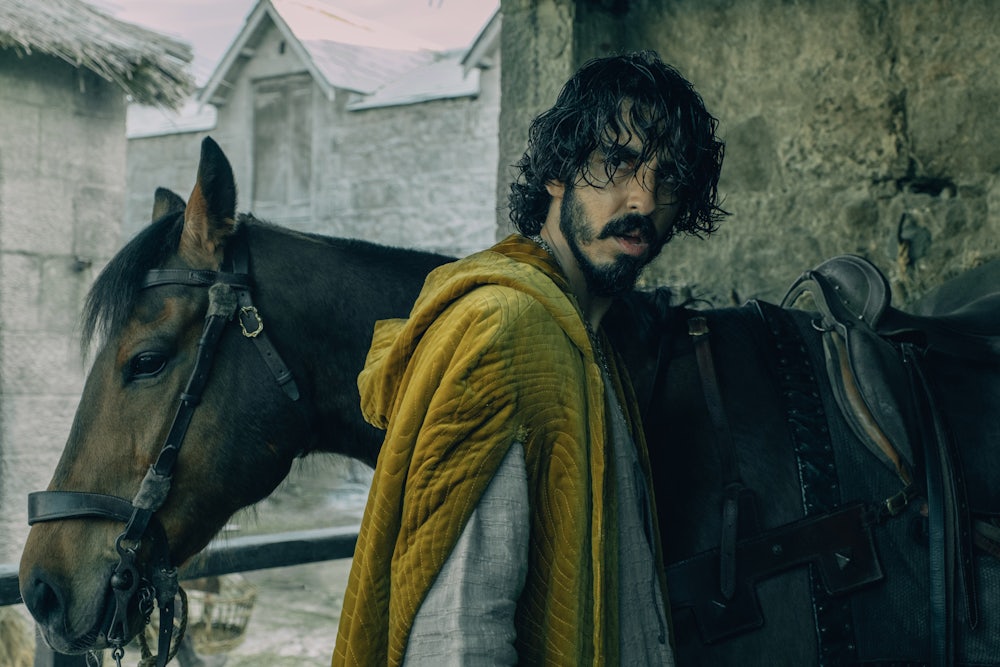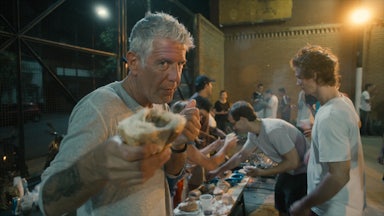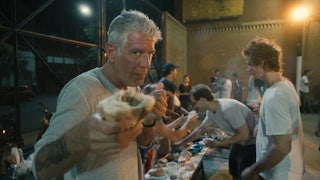It is Christmas Day in a great castle. King Arthur and Guinevere and their knights are feasting, when a green man on a big green horse bursts through the door. He lays down a bizarre challenge: He invites anyone of the assembled company to strike him with a weapon, as long as that person comes and finds him one year from now to receive the same stroke in return. This second part of the challenge is mystifying, since if one of them cuts the Green Knight’s head off, presumably he won’t be in a state to do anything next year. Gawain, Arthur’s nephew, accepts, and chops off the visitor’s big green head. Horribly, the mysterious knight picks it up and rides away.
A year zips past, and Gawain must set off to find his verdant opponent, kicking off the bulk of the action. The quest he goes on is an action adventure, yes, but also a tale about a promising young man going out to test himself, to see if he’s fit to become one of King Arthur’s famous Round Table retainers. On the adventures he faces during his travels, Gawain has to try to balance the demands of chivalry with his own personal desires, especially his impulses toward sex and violence, and frequently finds the task impossible. As such, the story concerns failure as much as success, grief as much as joy, and weakness as much as might.
The medieval poem Sir Gawain and the Green Knight relates this eerily playful tale in 2,530 lines of alliterative verse, a springy and musical metrical form, relishing the gory details. “The blood spurted from the body, bright against the green,” the poet notes, when Gawain slashes the Green Knight’s head off—an image that becomes a dance of color, blood, and moss and stone winding around each other on the floor in The Green Knight, a sumptuous new movie adaptation directed by David Lowery.
The movie plunges into medieval costume and décor, giving Dev Patel as Gawain opportunities for swishing capes and elegant horse riding. But it also takes seriously the enduring moral questions of the poem, particularly its concern with the public consequences of private indiscretions. In Lowery’s version, The Green Knight is a rare confrontation with the fact that how you have sex and commit violence does actually matter. In fact, the movie argues, it matters in directly inverse proportion to how little it seems to matter at the time you make your decision: an orgasm here, a swing of a sword there, and 40 years later all your crops are dead and there’s a furious bastard son shelling your castle.
Unlike the poem, which depicts the court as a lively place full of mirth, Lowery’s Round Table is gloomy and contemplative, with an ecclesiastical atmosphere. Everything, in this film, is colored in muted, organic shades, from the bluish tinge of an elderly cheek to Patel’s own shining brown eyes. Against that subdued palette, the greenness of the Green Knight appears otherworldly—tinged with the greenness of envy but also the greenness of a naïve young lad. Water, rocks, and weather are all practically characters in the Gawain story (he nearly dies of cold in the snow as he pushes on with his quest, the poet notes), and Patel does an excellent job of showing how physical discomfort can undermine the noblest character.
Beheading is a deeply surreal and visceral kind of violence—used to great effect in Ari Aster’s Hereditary—and Lowery makes the most of all the opportunities he can find to make heads roll on floors. The film gives us not just the opening beheading (and the promise of another beheading one year later), but as Patel’s Gawain rides out into the wilderness to find his challenger, he meets a pretty young girl named Saint Winifred, who claims that her rapist cut off her head and threw it in a pond. Would Gawain be so kind as to fish it out? She’s reminiscent of several girl saints celebrated in the medieval period, such as Saint Margret, who exploded out of a dragon, which tried to eat her, or Saint Osgyth, who was beheaded by pirates but picked up her head and walked off. The way the movie scene is played, it’s very funny, but funny in the way that sad and violent medieval saint stories often are: just so literal and eerie that you can’t help but laugh from shock.
On his way to find the Green Knight, Gawain meets giants, thieves, and oddly friendly foxes, before finally coming across a castle where a grand knight named Bertilak (Joel Edgerton) and the wildly flirtatious lady of the house (Alicia Vikander) will test Gawain’s chivalric bona fides to the limit. It’s here, at castle Hautdesert, that Gawain’s quest becomes something extraordinary, and his split loyalties to women (who want to be wooed here, according to chivalric convention) and to the male head of the household (who wants his loyalty, also according to chivalric convention) come into terrible conflict with one another.
One morning at Bertilak’s manor, the poem goes, the lady of the house sneaks in and sits on Gawain’s bedside. Horrified, and in one of the least heroic moments in all of the massive canon of Arthurian romance, he pretends to be asleep. In the film, the lady bears an eerie resemblance to a girlfriend of Gawain’s back home, and her come-ons are made more terrifying by the fact that she possesses a huge library of books, which she claims to have read, and some even written. She is more confident than him, wiser, better-educated, and able to use the code of manners against him. To reject her would insult her beauty; and yet to succumb would be to insult her husband’s hospitality.
In the film, both Gawain’s mother and Bertilak’s lady give Gawain belts of green fabric, which will supposedly protect him. They are some of the many knots tied in the story, which also include the pentangle symbol he wears on his shield (representing his five senses, the actions of his five fingers, the five wounds of Christ, and so on); the mystery of the Green Knight overall; and the contortions of conscience Gawain tangles himself up in. If his mother’s knotted belt symbolizes her unconditional and perfect love, Bertilak’s lady represents something else: Whatever is once knotted, it explains, cannot be undone, and if a man lets his body respond to temptation, even once, then he may never be able to undo the consequences. Things knot inside women’s bodies, and they last longer than pleasure. In an ambiguous vision, the knotted belt appears to melt into Gawain’s flesh, both a symbol of his mother’s love and his inability to live up to it, and as irrevocably bound into him as a guilty conscience.
The ending of any Gawain interpretation should remain a mystery, including this one, because it relies on a twist that rivals that in Hitchcock’s Vertigo (a movie also heavily reliant on green-colored lighting to symbolize transformation and disguise) in upending the meaning of all that has gone before it. But suffice to say there is magic involved. In Lowery’s movie, as in the poem, however, magic does not function as a deus ex machina to tie up loose ends but as a way to talk about control.
In one of The Green Knight’s cleverest motifs, Lowery has a group of children gather in front of a puppet show, where little wooden figures act out the beheading game as entertainment. It’s a knowing nod to the existence of the movie, but more importantly it shows how trapped Gawain has already become in the binds of the story before he even leaves the court; how far he has already become a wooden figure in a story rather than a man living his life.
We are all trapped in the little Punch and Judy show of our lives, trying to live up to expectations while weighed down by our armor, and nobody can ever know to what degree they are being manipulated. As Bertilak’s frightening wife puts it in a speech that lies at the movie’s heart, “Red is the color of lust, but green is what red leaves behind”: Whether those consequences will be the green of rot or of flourishing is a question a thousand years in the asking.








